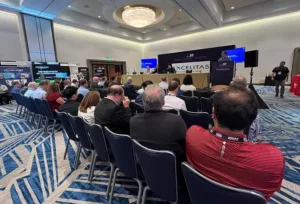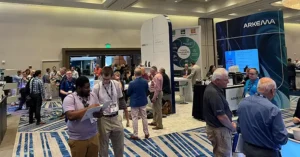 The 2024 IUVA Americas conference and exhibition was held Orlando, Florida, May 20-22, at the Hyatt Regency Orlando. Co-located with RadTech 2024, more than 75 exhibitors were on hand for attendees interested in the recent advancements in technology and research addressing the environmental, health and treatment process challenges of today, as well as to discuss the current trends in UV regulations and new applications.
The 2024 IUVA Americas conference and exhibition was held Orlando, Florida, May 20-22, at the Hyatt Regency Orlando. Co-located with RadTech 2024, more than 75 exhibitors were on hand for attendees interested in the recent advancements in technology and research addressing the environmental, health and treatment process challenges of today, as well as to discuss the current trends in UV regulations and new applications.
The event featured three days of technical sessions and expert panels, featuring industry advances and applications related to public health, drinking water, reuse water and wastewater treatment, air pollution, hospital infections, ballast water treatment and industrial effluents. New applications for UV technology also were reviewed.
During an awards dinner at the event, the RadLaunch Class of 2024 was announced, connecting start-up technology to established UV industry leaders. The 2024 class members are as follows:
Lumaegis: RadBox
Lumaegis’ RadBox is a sterilization device that uses a semiconductor-based solution i.e., UV-C and IR Light Emitting Diodes (LEDs) to generate germicidal radiation and heat. This solid-state-based microbicidal platform eliminates all forms of micro-fauna on the surface of solid surgical and probing-type instruments used in common surgical procedures, usually in a medical office setting and other surgical specialties of dentistry. The RadBox sterilizes surgical tools in just minutes, while overcoming many of the limitations of other devices. The RadBox device does not use any water and easily can be integrated to existing infection prevention and control (IPC) workflow. In addition, since there is no energy-intensive steam generation process, the power consumption is less than 5% compared to equivalent autoclave devices. Lumaegis medical devices use specific combinations of wavelengths to attack DNA and RNA structure, i.e., thymine dimerization and denaturing protein molecules. The anti-microbial properties of UV-C radiation are well known. The initial target market is oral healthcare practitioners, who actually helped develop the concept and design of RadBox.
XCMR, Inc.: Near-Field Infection Protection
XCMR’s Near-field Infection Protection (NIP)™ technology creates a biosafety barrier against aerosol transmission of infectious disease in close-contact environments. This innovative approach incorporates UV-C, for the first time, into wearable, portable and stationary devices to form a protective “invisible” bubble, enhancing infection prevention and addressing antimicrobial resistance concerns. XCMR’s NIP inactivation mechanism is agnostic to the pathogen and offers the promise of noninvasive immediate personal protection. XCMR’s modular UV-C reactors offer significant energy savings over traditional technologies. XCMR’s NIP tech is the foundation for the current application of XCMR’s Symmetrical Flow Disinfection™ (SFD) mask program. The modular design of XCMR’s NIP reactors is the basis for the company’s next generation of protection components initially designed for the military, healthcare workers, and first responders. However, the innovation extends to protect immunocompromised patients as well as the general population with consumer-grade implementations.
Spectrum Medical Technologies – Surgical Site Light™
 The Surgical Site Light is a patented, clinical phototherapy platform which utilizes Far UV-C to prevent surgical site infections and/or treat chronic nonhealing wounds. It is designed to be used directly on patients and is effective against antibiotic resistant pathogens (bacterial and fungal) and viruses. This is increasingly important as antibiotic-resistant pathogens are a serious threat to global health care. This gives clinicians another tool to combat the global challenge of antibiotic-resistant infections, reducing patient morbidity and mortality from these infections. This device has global appeal as it addresses the multi-billion-dollar cost of surgical site infections, as well as the multi-billion-dollar cost of treating chronic nonhealing wounds. Customers include any facility with an operating room (civilian and military hospitals) and chronic wound clinics. Because the device is portable and durable, it can be used by visiting nurses (VNA) to treat homebound patients as well as frontline military hospitals (MASH units).
The Surgical Site Light is a patented, clinical phototherapy platform which utilizes Far UV-C to prevent surgical site infections and/or treat chronic nonhealing wounds. It is designed to be used directly on patients and is effective against antibiotic resistant pathogens (bacterial and fungal) and viruses. This is increasingly important as antibiotic-resistant pathogens are a serious threat to global health care. This gives clinicians another tool to combat the global challenge of antibiotic-resistant infections, reducing patient morbidity and mortality from these infections. This device has global appeal as it addresses the multi-billion-dollar cost of surgical site infections, as well as the multi-billion-dollar cost of treating chronic nonhealing wounds. Customers include any facility with an operating room (civilian and military hospitals) and chronic wound clinics. Because the device is portable and durable, it can be used by visiting nurses (VNA) to treat homebound patients as well as frontline military hospitals (MASH units).
SpaceUV Systems
Upper-air UVGI is poised to be in the forefront of air disinfection in coming years. Not only is it sustainable in terms of energy consumption, it offers exceptional and noiseless air disinfection efficiency, making it ideal for indoor use in offices, academia and beyond. SpaceUV has redesigned upper-air UVGI fixtures to address the challenge of high ambient dust levels in India. By reconfiguring the fixture optics using multi-physics raytrace simulations, the designs have enabled use of upper-air UVGI in high ambient air dust conditions, enabling wider adoption. The company now is ready with a portfolio of products that can leverage the early mover advantage for cost-conscious Indian healthcare systems and beyond – seamlessly enabling compliance with ASHRAE 241. SpaceUV is a strategic effort toward safe, clean and sustainable additions to existing HVAC systems, offering lower cost of IAQ compliance without need for drastic increase in air ventilation and associated energy costs.
Elec-Field Future Corp.: Carbon Nano Tube (CNT) UV Disinfection Lamp Using Nanotechnology
This energy-efficient lamp, with a 300 W output at a 273 nm wavelength, is being developed for water purification, bio clean rooms, vertical farming and residential applications. The Elec-Field Future UV disinfection lamp is anchored in advanced nanotechnology, specifically utilizing carbon nanotubes (CNT). One of its pivotal engineering feats is its unique directional design, which optimizes energy efficiency by focusing the emitted UV light to the desired location. Furthermore, this digital method is pivotal for the lamp’s ability to produce noncolored UV emissions, a feature not commonly found in the industry. The material choice of CNT bypasses certain environmental concerns and extends the product’s lifespan to an impressive three years. Additionally, the lamp’s modular nature suggests adaptability, with potential for x-ray generation through module replacement. This combination of material innovation, digital light generation and modular design ensures the lamp’s proficiency.






